new posts in all blogs
Viewing: Blog Posts Tagged with: jessixa bagley, Most Recent at Top [Help]
Results 1 - 7 of 7
How to use this Page
You are viewing the most recent posts tagged with the words: jessixa bagley in the JacketFlap blog reader. What is a tag? Think of a tag as a keyword or category label. Tags can both help you find posts on JacketFlap.com as well as provide an easy way for you to "remember" and classify posts for later recall. Try adding a tag yourself by clicking "Add a tag" below a post's header. Scroll down through the list of Recent Posts in the left column and click on a post title that sounds interesting. You can view all posts from a specific blog by clicking the Blog name in the right column, or you can click a 'More Posts from this Blog' link in any individual post.
Jessixa Bagley and Don Tate took part in our panel on picture books. Jessixa is the Golden Kite winner for picture book texts, and Don has won numerous awards for his critically acclaimed texts and illustrations.
What makes a picture book successful? There's a sense of completion to it,
Jessixa said. It doesn't assume that the reader has knowledge about the subject. There's nothing left hanging. It's like an amuse bouche, a perfect bite. She's also drawn to books with a really deep meaning—a meaning that can be joyful too.
Don loves it when people can flip through his book and know the story by the pictures. He loves making emotional connection with readers. We connect with our readers through emotions. Page turns help guide readers from left to right through the story. "I like it when the illustrator has really done their job ... and you want to linger and live in that space for a while."
When it comes to developing stories for markets Don doesn't illustrate books differently on whether they're commercial or more for libraries. Don loves to illustrate books about little-known historical figures, which typically puts his books into the school/library market. This lets him do more school visits.
Jessixa also doesn't think about making books directly for markets, and thinks that books with emotional content can be really useful in school markets.
What collaborations help? Don is in several critique groups. They help him make his manuscripts stronger for agents.
Jessixa says you should treat your work like a baby egg. Nurture it until it gets a little more solid, and then you can share it. You won't be as hurt by the feedback. It won't be as bruising. It will be able to hatch. "We've all had the experience where you work on something really hard and you show it to someone and they don't respond to it, and you're gutted."
Advice: Don: Be sure to keep your stories child-focused. It's important to engage a child by beginning in childhood. Children like to see themselves represented on the first page of a book. He's not a fan of labeling books by gender. Sometimes, books appeal more to boy than to girls. But you don't need to labels. "Let the readers find them where they will."
Jessixa wasn't a girly girl. She wasn't a tomboy. She was just herself, so she gravitated toward identity-neutral things. There is universality to her work that she wants to extend. "I have a hard time with the fact that there are pink LEGOs and those are the girl LEGOs."
"Allowing the space to have things appeal to more people, whether it's gender or diversity, is going to make us all a lot stronger."
.jpeg?picon=2287)
By: Lee Wind, M.Ed.,
on 7/30/2016
Blog:
The Official SCBWI 10th Annual New York Conference Blog
(
Login to Add to MyJacketFlap)
JacketFlap tags:
#LA16SCBWI,
picture books,
Don Tate,
john parra,
Laurent Linn,
Barney Saltzberg,
Susan Rich,
jessixa bagley,
Add a tag
Moderated by Laurent Linn (standing), the panelists, left to right, are: author/illustrator Jessixa Bagley, illustrator John Parra, editor Susan Rich, author/illustrator Barney Saltzberg, and author/illustrator Don Tate.
Jessixa Bagley is by far Seattle's favorite Jessixa, and she'll be yours, too. BOATS FOR PAPA is a beautiful, lyrical book and her fellow Seattleites are thrilled that she/it have received this fantastic award.
In her acceptance speech, Jessixa thanks SCBWI, her lovely agent,
Alexandra Penfold, and her stellar editor,
Neal Porter. Jessixa got teary as she thanked her artist/author husband,
Aaron Bagley, who she says helped her find her voice.
Jessixa says, upon receiving the call from SCBWI that she'd won the Golden Kite for Picture Book Text, that her Illustrator Brain thought,
"Text!? Did my illustrations suck?"But luckily her Author Brain piped up and said,
"Hey! This is great!"
Jessixa's always felt much more comfortable calling herself an artist, "Calling myself an author... Author almost seemed like a taboo word... It seems like a dream now to be up on this stage. I went from thinking I'd never be published, to being here. Writing picture books is the hardest thing I've ever done, but also the most rewarding."
I love Jessixa's inspiring, concluding thoughts to us: She says if we haven't found our voice yet, to not be scared, it's there. It might be really quiet, but the more you write, the louder it will become.
Congratulations, Jessixa!!!
 This is one gorgeous picture book. It’s perhaps even more remarkable, given that it’s by a debut artist. Since its publication last June, it has gotten lots of love. And even more love.
This is one gorgeous picture book. It’s perhaps even more remarkable, given that it’s by a debut artist. Since its publication last June, it has gotten lots of love. And even more love.
Most reviews refer to the way the story tugs at the heartstrings: “A weeper.” “Heart-breaking.” I have to say that the message I took away from the book was less Look How Much They Love Each Other and more Watch This Young Boy Become an Artist. By trying to make the best boat possible for his absent father, Buckley hones his craft: “And each time he made a new boat, it was even better than the last.” Little by little, through hard work and incentive and love and practice and more practice, we see his initial crude efforts — essentially just hunks of driftwood with sticks for masts — become sophisticated, complex, intricate, beautifully crafted works of art.
The ink and watercolor illustrations are simply stunning. The watercolor medium is of course an apt one for this edge-of-the-ocean tale, but that doesn’t begin to express how completely Bagley captures the look and feel of a driftwood- and seaweed-strewn shore. From the colors of water, sand, and sky at various times of day to the way she conveys that sometimes-undefinable edge between ocean and beach and between ocean and sky: it’s all spectacular. She also transitions organically from the shorescapes to the scenes set inside Buckley’s humble home. The use of line (and ink) in the indoor scenes make them tighter and more controlled, and yet the edges of the pictures always retain that watery feel, linking them to the outdoor scenes.
The endpapers are both thematically meaningful and glorious. I love how the driftwood scattered over the beach on the opening endpapers then morph into Buckley’s finished boats hanging on his display wall on the closing endpapers. The endpapers visually reflect the book’s theme of turning raw materials into art.
There are a few things that throw me off a bit:
- Why are the characters beavers? It seems an odd choice for a book set not by a lake or pond but by the sea.
- For a debut picture book creator, Bagley seems comfortable and in control. She allows the story to unfold at a very deliberate and leisurely pace. She has confidence in her ability to hold readers’ attention for what is really (outwardly, at least) a not-very-eventful story. Nevertheless, the pacing at the start is off, for me. The book opens with a series of double-page spreads of the shorescape, and they set the scene beautifully. But, if you count the opening endpapers, we get four of these scene-setting double-page spreads, and then the first time we get to the true meat of the book — Buckley making things with his hands — that happens in a teeny little vignette.
- I can’t shake the feeling that the story has an adult sensibility. Everyone seems to agree that the book will generate strong emotions in readers, but I see more adults getting all choked up than children. However, this may not be of primary importance to the Caldecott committee, which is looking at the art first and the text/story only secondarily.
Over to you all! What are your thoughts about this very impressive picture book debut and its chances on the Caldecott table?
The post Boats for Papa appeared first on The Horn Book.

By:
Betsy Bird,
on 7/7/2015
Blog:
A Fuse #8 Production
(
Login to Add to MyJacketFlap)
JacketFlap tags:
Jessixa Bagley,
Best Books of 2015,
Reviews 2015,
2015 picture books,
2015 reviews,
Reviews,
picture books,
death,
grief,
Best Books,
Add a tag
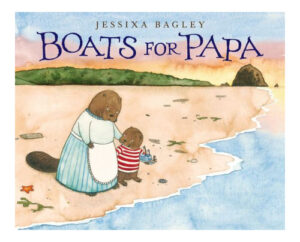 Boats for Papa
Boats for Papa
By Jessixa Bagley
Roaring Brook Press (an imprint of Macmillan)
$17.99
ISBN: 978-1626720398
Ages 4-7
On shelves now
So I’m a snob. A children’s literature snob. I accept this about myself. I do not embrace it, but I can at least acknowledge it and, at times, fight against it as much as I am able. Truth be told, it’s a weird thing to get all snobby about. People are more inclined to understand your point of view when you’re a snob about fine china or wines or bone structure. They are somewhat confused when you scoff at their copy of Another Monster at the End of This Book since it is clearly a sad sequel of the original Jon Stone classic (and do NOT even try to convince me that he was the author of that Elmo-related monstrosity because I think better of him than that). Like I say. Kid book snobbery won’t get you all that far in this life. And that’s too bad because I’ve got LOADS of the stuff swimming between my corpuscles. Just take my initial reaction to Jessixa Bagley’s Boats for Papa. I took one glance at the cover and dismissed it, just like that. I’ll explain precisely why I did so in a minute, but right there it was my gut reaction at work. I have pretty good gut reactions and 99% of the time they’re on target. Not in this case, though. Because once I sat down and read it and watched other people read it, I realized that I had something very special on my hands. Free of overblown sentiment and crass pandering, this book’s the real deal. Simultaneously wrenching and healing.
Buckley and his mama are just two little beavers squeaking out an existence in a small wooden house by the sea. Buckley loves working with his hands (paws?) and is particularly good at turning driftwood into boats. One day it occurs to him to send his best boats off into the sea with little notes that read, “For Papa. Love, Buckley”. Buckley misses his papa, you see, and this is the closest he can get to sending him some kind of a message. As Buckley gets better, the boats get more elaborate. Finally, one day a year later, he runs into his house to write a note for papa, when he notices that his mother has left her desk open. Inside is every single boat he ever sent to his papa. Realizing what has happened, Buckley makes a significant choice with this latest seagoing vessel. One that his mama is sure to see and understand.
The danger with this book is determining whether or not it slips into Love You Forever territory. Which is to say, does it speak more to adults than to kids. You get a fair number of picture books with varying degrees of sentimentality out there every year. On the low end of the spectrum is Love You Forever, on the high end Blueberry Girl and somewhere in the middle are books like Someday by Alison McGhee. Some of these can be great books, but they’re so clearly not for kids. And when I realized that Boats for Papa was a weeper my alarm bells went off. If adults are falling over themselves to grab handkerchiefs when they get to the story’s end, surely children would be distinctly uninterested. Yet Bagley isn’t addressing adults with this story. The focus is on how one deals with life after someone beloved is gone. Adults get this instantly because they know precisely what it is to lose someone (or they can guess). Kids, on the other hand, may sometimes have that understanding but a lot of the time it’s foreign to them. And so Buckley’s hobbies are just the marks of a good story. I suspect few kids would walk away from this saying the book was uninteresting to them. It seems to strike just the right chord.
It is also a book that meets multiple needs. For some adult readers, this is a dead daddy book. But upon closer inspection you realize that it’s far broader than that. This could be a book about a father serving his time overseas. It could be about divorced parents (it mentions that mama misses papa, and that’s not an untrue sentiment in some family divorce situations). It could have said outright that Buckley’s father had passed away (ala Emmet Otter’s Jugband Christmas which this keeps reminding me of) but by keeping it purposefully vague we are allowed to read far more into the book’s message than we could have if it was just another dead parent title.
Finally, it is Bagley’s writing that wins the reader over. Look at how ecumenical she is with her wordplay. The very first sentences in the book reads, “Buckley and his mama lived in a small wooden house by the sea. They didn’t have much, but they always had each other.” There’s not a syllable wasted there. Not a letter out of place. That succinct quality carries throughout the rest of the book. There is one moment late in the game where Buckley says, “And thank you for making every day so wonderful too” that strains against the bonds of sentimentality, but it never quite topples over. That’s Bagley’s secret. We get the most emotionally involved in those picture books that give us space to fill in our own lives, backgrounds, understandings and baggage. The single note reading, “For Mama / Love, Buckley” works because those are the only words on the page. We don’t need anything else after that.
As I age I’ve grown very interested in picture books that touch on the nature of grace. “Grace” is, in this case, defined as a state of being that forgives absolutely. Picture books capable of conjuring up very real feelings of resentment in their young readers only to diffuse the issue with a moment of pure forgiveness are, needless to say, rare. Big Red Lollipop by Rukhsana Khan was one of the few I could mention off the top of my head. I shall now add Boats for Papa to that enormously short list. You see, (and here I’m going to call out “SPOILER ALERT” for those of you who care about that sort of thing) for me the moment when Buckley finds his boats in his mother’s desk and realizes that she has kept this secret from him is a moment of truth. Bagley is setting you up to assume that there will be a reckoning of some sort when she writes, “They had never reached Papa”. And it is here that the young reader can stop and pause and consider how they would react in this case. I’d wager quite a few of them would be incensed. I mean, this is a clear-cut case of an adult lying to a child, right? But Bagley has placed Buckley on a precipice and given him a bit of perspective. Maybe I read too much into this scene, but I think that if Buckley had discovered these boats when he was first launching them, almost a full year before, then yes he would have been angry. But after a year of sending them to his Papa, he has grown. He realizes that his mother has been taking care of him all this time. For once, he has a chance to take care of her, even if it is in a very childlike manner. He’s telling her point blank that he knows that she’s been trying to protect him and that he loves her. Grace.
Now my adult friends pointed out that one could read Buckley’s note as a sting. That he sent it to say “GOTCHA!” They say that once a book is outside of an author’s hands, it can be interpreted by the readership in any number of ways never intended by the original writer. For my part, I think that kind of a reading is very adult. I could be wrong but I think kids will read the ending with the loving feel that was intended from the start.
When I showed this book to a friend who was a recent Seattle transplant, he pointed out to me that the coastline appearing in this book is entirely Pacific Northwest based. I think that was the moment I realized that I had done a 180 on the art. Remember when I mentioned that I didn’t much care for the cover when I first saw it? Well, fortunately I have instituted a system whereby I read every single picture book I am sent on my lunch breaks. Once I got past the cover I realized that it was the book jacket that was the entire problem. There’s something about it that looks oddly cheap. Inside, Bagley’s watercolors take on a life of their own. Notice how the driftwood on the front endpapers mirrors the image of Buckley displaying his driftwood boats on the back endpapers. See how Buckley manages to use her watercolors to their best advantage, from the tide hungry sand on the beach to the slate colored sky to the waves breaking repeatedly onto the shore. Perspective shifts constantly. You might be staring at a beach covered in the detritus of the waves on one two-page spread, only to have the images scale back and exist in a sea of white space on the next. The best image, by far, is the last though. That’s when Bagley makes the calculated step of turning YOU, the reader, into Mama. You are holding the boat. You are holding the note. And you know. You know.
I like it when a picture book wins me over. When I can get past my own personal bugaboos and see it for what it really is. Emotional resonance in literature for little kids is difficult to attain. It requires a certain amount of talent, both on the part of the author and their editor. In Boats for Papa we’ve a picture book that doesn’t go for the cheap emotional tug. It comes by its tears honestly. There’s some kind of deep and abiding truth to it. Give me a couple more years and maybe I’ll get to the bottom of what’s really going on here. But before that occurs, I’m going to read it with my kids. Even children who have never experienced the loss of a parent will understand what’s going on in this story on some level. Uncomplicated and wholly original, this is one debut that shoots out of the starting gate full throttle, never looking back. A winner.
On shelves now.
Source: Galley sent from publisher for review.
Like This? Then Try:
Misc: Be sure to check out this profile of Jessixa Bagley over at Seven Impossible Things Before Breakfast.


By: Samantha McGinnis,
on 5/26/2015
Blog:
First Book
(
Login to Add to MyJacketFlap)
JacketFlap tags:
diversity,
Books & Reading,
Authors & Illustrators,
The Stories for All Project,
Stories For All Project,
Jessixa Bagley,
diverse books,
Laurie Ann Thompson,
Inclusivity,
Twitter Chats,
Add a tag
Today’s blog post is part of our Stories For All Project series, focused on sharing the latest announcements and impact stories about our effort to put diverse, inclusive books into the hands of kids.
Jessixa Bagley and Laurie Ann Thompson authored two of our 2015 Stories for All Project title selections. The new picture book authors recently joined us for a Twitter chat to discuss their books “Boats for Papa” and ”Emmanuel’s Dream: The True Story of Emmanuel Ofosu Yeboah” and why diversity and inclusion are important in children’s stories.
Here are some of the highlights. You can see full answers to all seven questions and questions from our audience on the Storify for this chat.
Why do you think it is important that diverse books are available to all children?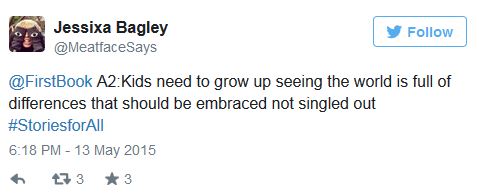
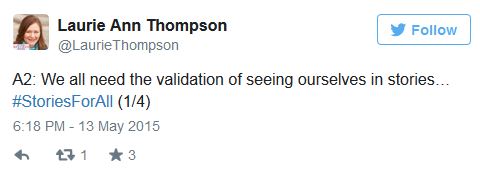
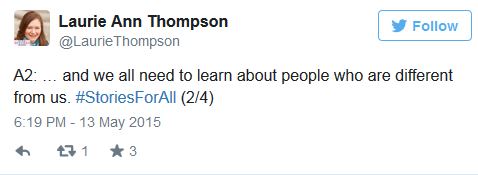
How can books featuring diverse voices and experiences contribute to inclusivity?
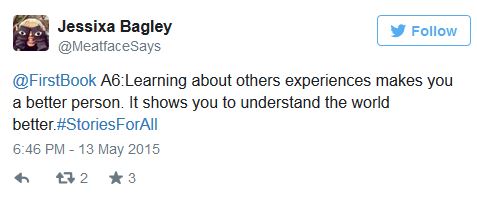
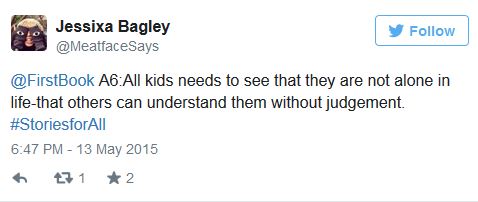
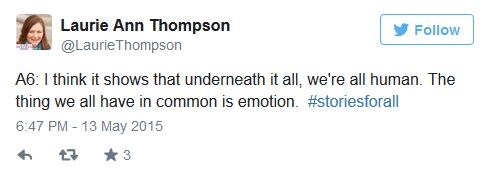
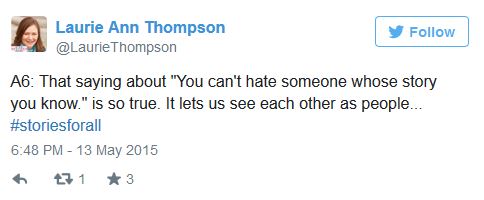
How have you seen your book affect a reader?
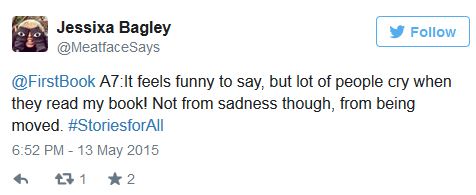
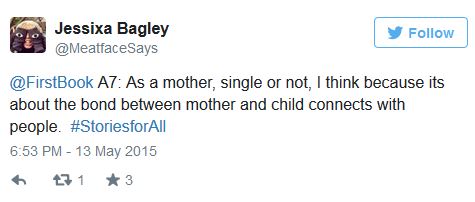
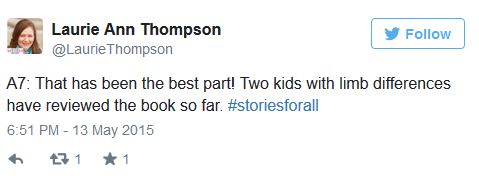
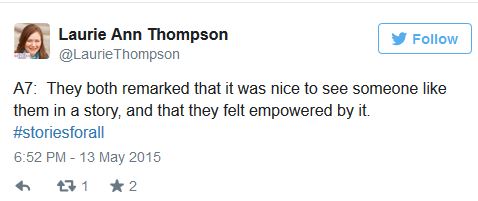
Find out more! View the Storify of this Twitter chat.
The post Jessixa Bagley and Laurie Ann Thompson Chat with First Book appeared first on First Book Blog.


By: Samantha McGinnis,
on 5/5/2015
Blog:
First Book
(
Login to Add to MyJacketFlap)
JacketFlap tags:
Social Entrepreneurship,
henry cole,
Target,
kpmg,
Justin Richardson,
Peter Parnell,
JetBlue,
The Stories for All Project,
Stories For All Project,
Nino Wrestles the World,
Tiger in My Soup,
Jessixa Bagley,
Boats for Papa,
Inclusivity,
Literacy,
Diversity,
Books & Reading,
Marketplace,
Education,
Yuyi Morales,
And Tango Makes Three,
Add a tag
When children see their lives reflected in the books they read they become more enthusiastic readers. Their educational outcomes improve. They succeed in school and in life.
But few books act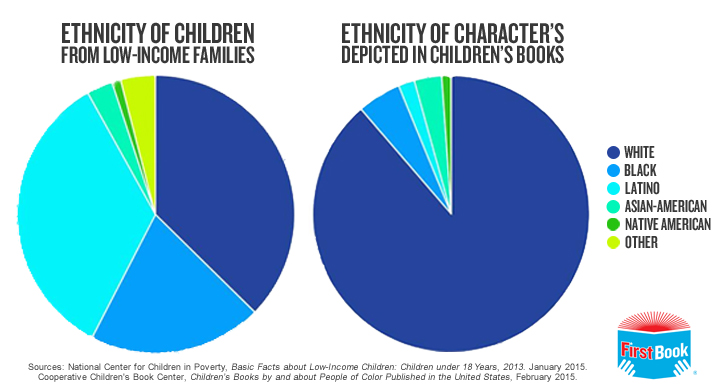 ually reflect the cultures and circumstances of the kids First Book serves, all of whom live in low-income households and many of whom are of minority backgrounds. In fact, a mere 11 percent of 3,500 children’s books reviewed by Cooperative Children’s Book Center this year are about people of color.
ually reflect the cultures and circumstances of the kids First Book serves, all of whom live in low-income households and many of whom are of minority backgrounds. In fact, a mere 11 percent of 3,500 children’s books reviewed by Cooperative Children’s Book Center this year are about people of color.
This is the reason we created the Stories for All ProjectTM – the only market-driven solution to increase diverse voices and promote inclusivity in children’s literature.
Today, we’re proud to share our latest news with you: With support from Target, KPMG and Jet Blue Airways, First Book is making 60,000 copies of outstanding children’s titles featuring diverse characters and storylines available for the first time ever in affordable trade paperback format, to fuel learning and educational equity.
We chose these titles from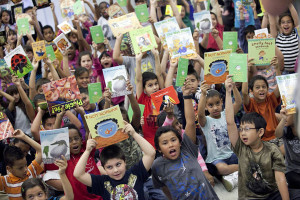 hundreds submitted by publishers with input from the 175,000 educators and program leaders we serve. By aggregating the demand and purchasing power of this educator community, we have become the first organization to create a viable and vibrant market for books that reflect race, ability, sexual orientation and family structure in our ever-diversifying world.
hundreds submitted by publishers with input from the 175,000 educators and program leaders we serve. By aggregating the demand and purchasing power of this educator community, we have become the first organization to create a viable and vibrant market for books that reflect race, ability, sexual orientation and family structure in our ever-diversifying world.
Each of our selections contributes unique perspectives underrepresented in children’s literature while remaining relatable to all readers. As part of this current effort, First Book is thrilled to make available two titles by new picture book authors:
- “Niño Wrestles the World” written and illustrated by Yuyi Morales
- “And Tango Makes Three” written by Justin Richardson and Peter Parnell and illustrated by Henry Cole
- “Tiger in My Soup” written by Kashmira Sheth and illustrated by Jeffrey Ebbeler
- “Boats for Papa” written and illustrated by new author/illustrator Jessixa Bagley
- “Emmanuel’s Dream: The True Story of Emmanuel Ofosu Yeboah,” written by first-time children’s author Laurie Ann Thompson and illustrated by Sean Qualls,
- “Knock Knock: My Dad’s Dream for Me,” written by Daniel Beaty and illustrated by Bryan Collier
Copies of all six titles will be available through the First Book Marketplace. The first three titles are also available for the first time in paperback format on Target.com and at Target stores nationwide.
Every day, in communities around the country and around the world, we see the critical need to further our human understanding and embrace the gifts and experience each of us brings. The Stories for All Project and promotes understanding, empathy and inclusivity with stories that can help all children see and celebrate their differences and similarities.
The post The Stories for All Project: 60,000 New Books to Increase Diversity, Promote Inclusivity appeared first on First Book Blog.







 This is one gorgeous picture book. It’s perhaps even more remarkable, given that it’s by a debut artist. Since its publication last June, it has
This is one gorgeous picture book. It’s perhaps even more remarkable, given that it’s by a debut artist. Since its publication last June, it has 












